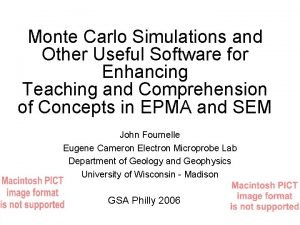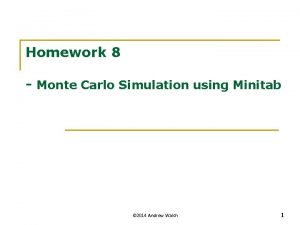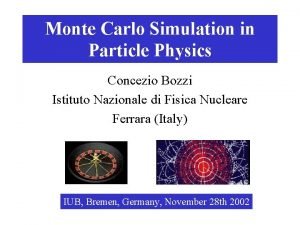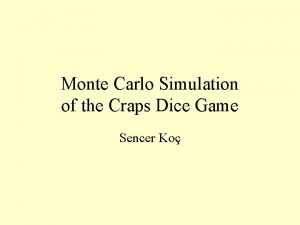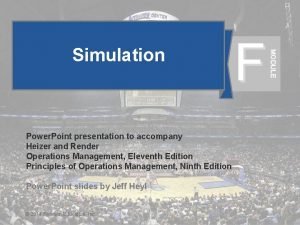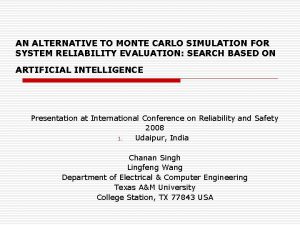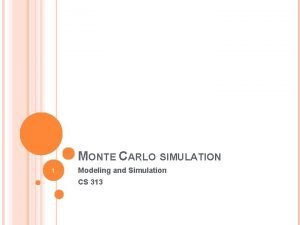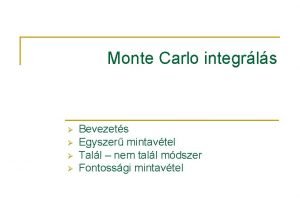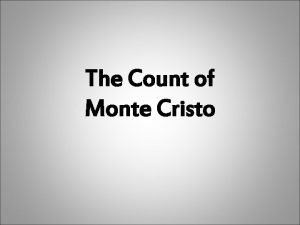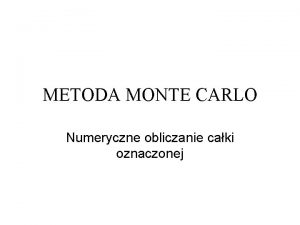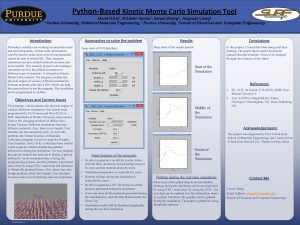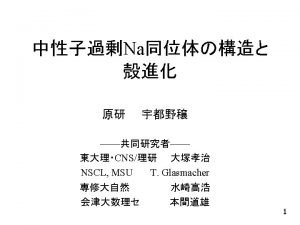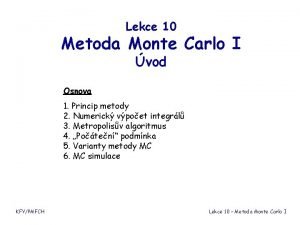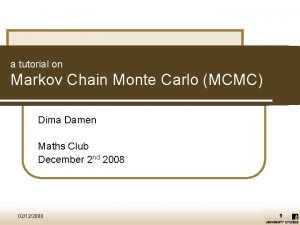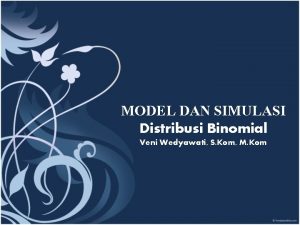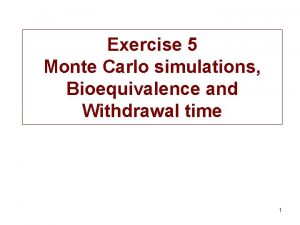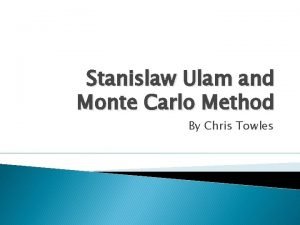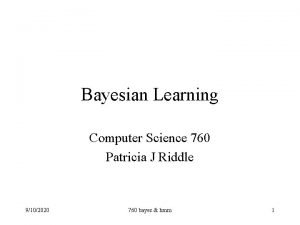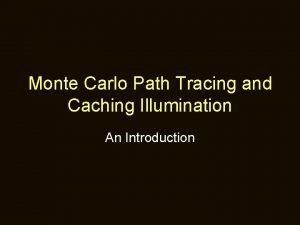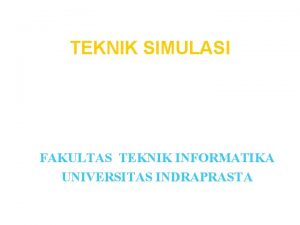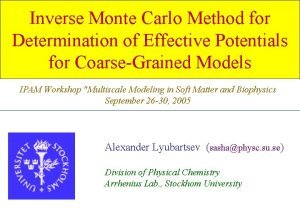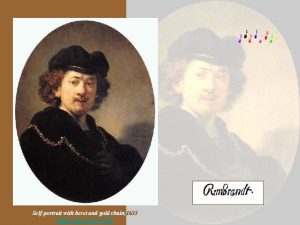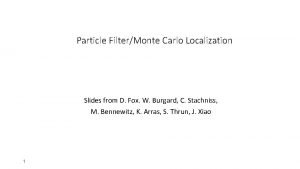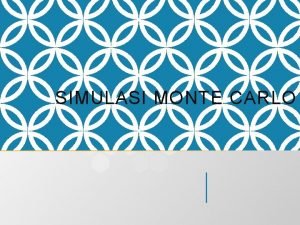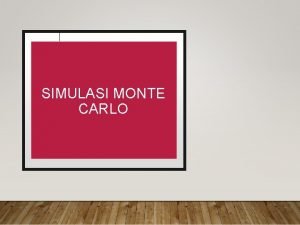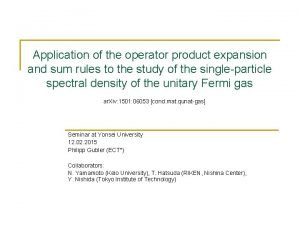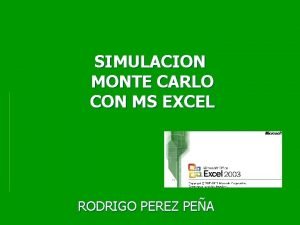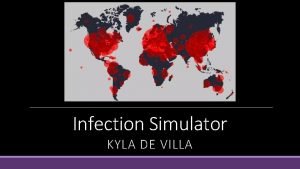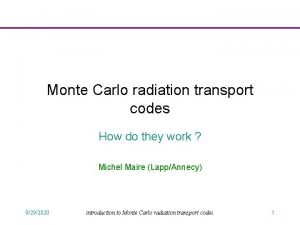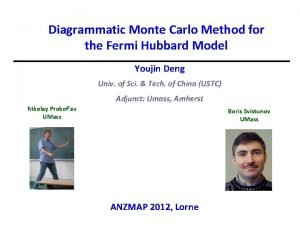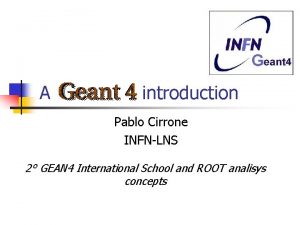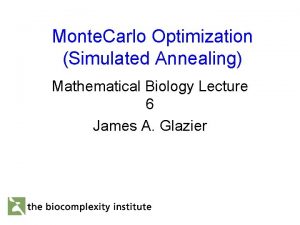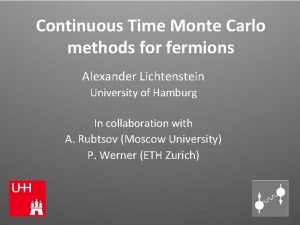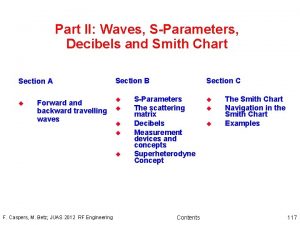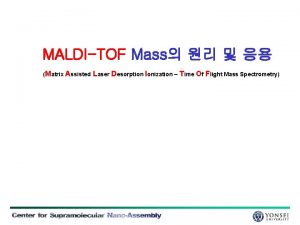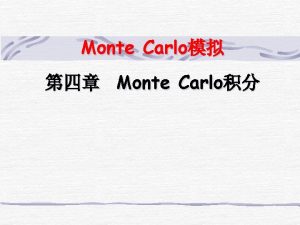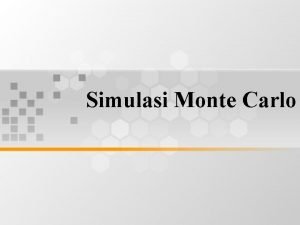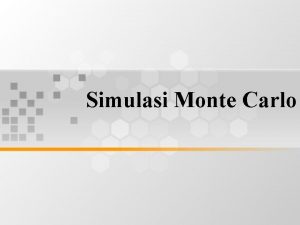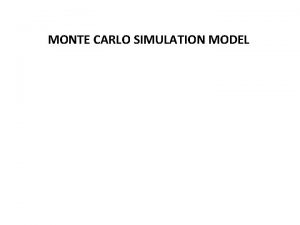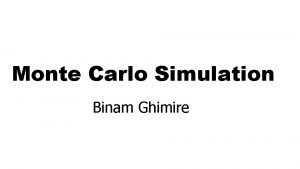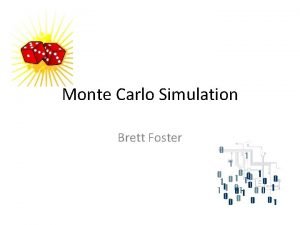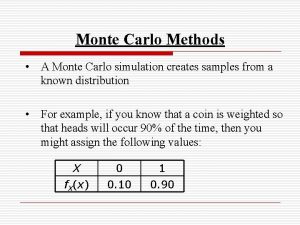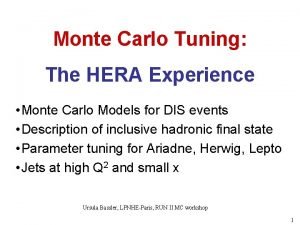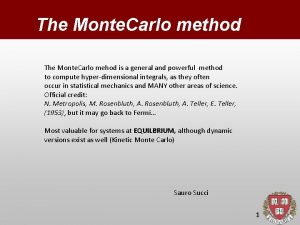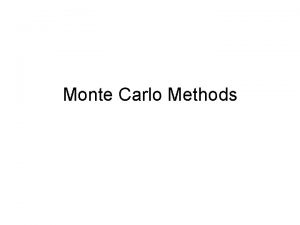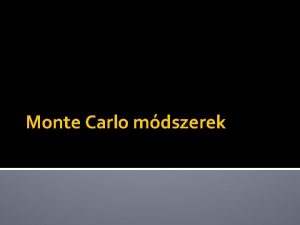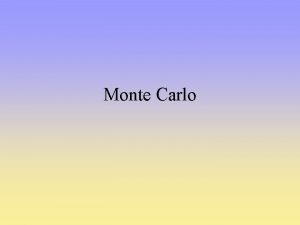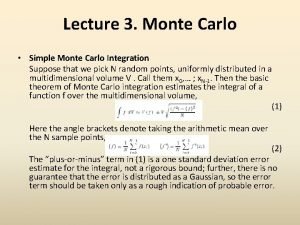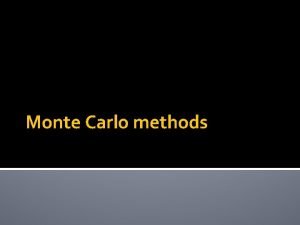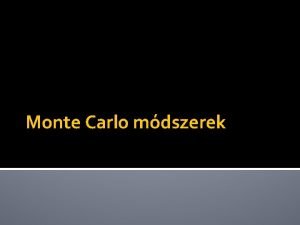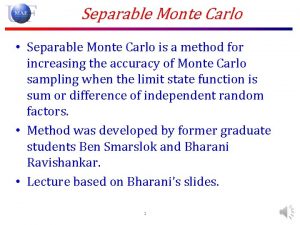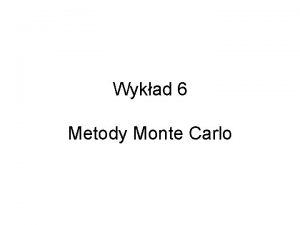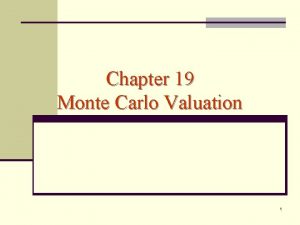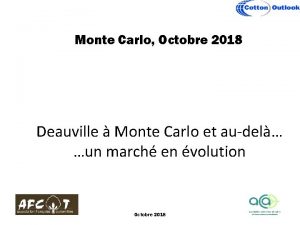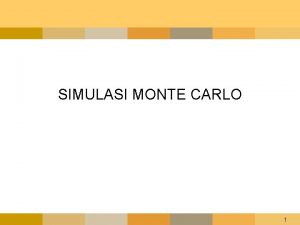Monte Carlo simulation Scattering simulation Simulation of normal














































- Slides: 46

Monte Carlo simulation

Scattering simulation �Simulation of normal light photons Does not change its energy on scattering �Homogenous and inhomogeneous media

Scattering simulation �The problem to solve Find the point of scattering ▪ Free path in the media Change of the energy Calculating the new direction �Monte Carlo methods Random samples Decision based on the local attributes

Scattering simulation �Radiative transfer equation screen Camera Outgoing radiancia: L(s+ds) path: ds Incident radiancia: L(s)

Scattering simulation �Probability of scattering �Probability of reflection albedo

Scattering simulation �Direction of the reflection Phase function Isotropic scattering Anisotropic scattering

Scattering simulation �Approximation of single scattering Radiance ▪ Direct part ▪ Indirect (media) part ▪ Volumetric representation

Scattering simulation �Stochastic solution Contributions to the radiance of a point ▪ Direct photon emission ▪ Single scattering ▪ Two-times scattered photons ▪. . . ▪ N-times scattered photons

Scattering simulation �Monte Carlo simulation Generating random light paths ▪ A path contains many photons ▪ Collecting the scattering points and their energy ▪ Free path

Scattering simulation �Monte Carlo simulation Weighting by probability ▪ Converting scattering events into volumetric radiance Gathering walks ▪ Viewpoint dependent summation ▪ Indirect and direct visualization methods

Scattering simulation �Implementation Photon structure ▪ Origin, direction, energy Radiance buffer ▪ 3 D array Random number generator ▪ Seed buffer

Scattering simulation __kernel void simulation(const int iteration, __global uint 4* seed, __global struct photon* photons, const int resolution, __global float* simulation. Buffer, const float 4 light. Source. Position){ int id = get_global_id(0); // random uint rng 1 uint rng 2 uint rng 3 uint rng 4 generator setup = seed[id]. s 0; = seed[id]. s 1; = seed[id]. s 2; = seed[id]. s 3; // scatter simulation if(0 == iteration || photons[id]. energy < 0. 2 f){ photons[id]. origin = light. Source. Position; photons[id]. direction = get. Random. Direction(&rng 1, &rng 2, &rng 3, &rng 4); photons[id]. energy = 1. 0 f; } else { photons[id]. direction = get. Random. Direction(&rng 1, &rng 2, &rng 3, &rng 4); } trace. Photon. RM(&photons[id], get. Random(&rng 1, &rng 2, &rng 3, &rng 4)); store. Photon(&photons[id], resolution, simulation. Buffer); } // random state store seed[id]. s 0 = rng 1; seed[id]. s 1 = rng 2; seed[id]. s 2 = rng 3; seed[id]. s 3 = rng 4;

Scattering simulation float 4 get. Random. Direction(uint* rng 1, uint* rng 2, uint* rng 3, uint* rng 4){ float x, y, z; bool inside = false; while(!inside){ x = get. Random(rng 1, rng 2, rng 3, rng 4) * 2. 0 f - 1. 0 f; y = get. Random(rng 1, rng 2, rng 3, rng 4) * 2. 0 f - 1. 0 f; z = get. Random(rng 1, rng 2, rng 3, rng 4) * 2. 0 f - 1. 0 f; if( (x*x + y*y + z*z) <= 1. 0 f){ inside = true; } } if( x*x + y*y + z*z == 0. 0){ x = 0. 0 f; y = 1. 0 f; z = 0. 0 f; } float vlen = sqrt(x*x + y*y + z*z); return (float 4)(x/vlen, y/vlen, z/vlen, 0); }

Scattering simulation void trace. Photon. RM(__global struct photon* p, float rnd){ // simple linear //p->origin = p->origin + p->direction * 0. 1 f; float s = -log(rnd) / density. Scale; float t = 0. 0 f; dt = 1. 0 f / 256. 0 f; sum = 0. 0 f; sigmat = 0. 0 f; while(sum < s){ float 4 sample. Pos = p->origin + t * p->direction; if(sample. Pos. x < 0. 0 f || sample. Pos. x > 1. 0 f || sample. Pos. y < 0. 0 f || sample. Pos. y > 1. 0 f || sample. Pos. z < 0. 0 f || sample. Pos. z > 1. 0 f){ p->energy = 0. 0 f; break; } else { sigmat = get. Density(sample. Pos); sum += sigmat * dt; t += dt; } } } p->origin = p->origin + p->direction * t; p->direction = p->direction; p->energy = p->energy * albedo;

Scattering simulation float get. Density(float 4 p){ // roof if(p. y > 0. 78 f && p. y < 0. 83 f && ( (p. x - 0. 5 f) * (p. x - 0. 5 f) + (p. z - 0. 5 f) * (p. z - 0. 5 f) ) > 0. 001 f) return 100. 0 f; // walls if(p. x < 0. 02 f) return 100. 0 f; if(p. y < 0. 02 f) return 100. 0 f; if(p. z > 0. 98 f) return 100. 0 f; // a more dense part near to the bottom if(p. y < 0. 2 f) return (1. 0 f - p. y) * 5. 0 f; } return 0. 5 f * density. Scale;

Scattering simulation void store. Photon(__global struct photon* p, const int resolution, __global float* simulation. Buffer){ if(p->energy < 0. 1 f) return; int x = p->origin. x * resolution; int y = p->origin. y * resolution; int z = p->origin. z * resolution; if(x > resolution -1 || x < 0) return; if(y > resolution -1 || y < 0) return; if(z > resolution -1 || z < 0) return; } simulation. Buffer[x+y*resolution+z*resolution] += p->energy;

Scattering simulation

Volume rendering �Visualization of a volumetric representation Temperature, pressure, density etc. v(x, y, z) storage: 3 D array

Volume rendering �Isosurface rendering Indirect method ▪ Marching cubes

Volume rendering �Isosurface rendering Direct method ▪ Isosurface raycasting Raycasting

Isosurface raycasting right up lookat q entry eye p exit p = lookat + right + up , are in [-1, 1] Unite cube with a 3 D texture

Isosurface raycasting __kernel void isosurface(const int width, const int height, __global float 4* visualization. Buffer, const int resolution, __global float* volume. Data, const float iso. Value, const float 16 inv. View. Matrix){ int 2 id = (int 2)(get_global_id(0), get_global_id(1)); float 2 uv = (float 2)( (id. x / (float) width)*2. 0 f-1. 0 f, (id. y / (float) height)*2. 0 f-1. 0 f ); float 4 box. Min = (float 4)(-1. 0 f, 1. 0 f); float 4 box. Max = (float 4)(1. 0 f, 1. 0 f); // calculate eye ray in world space struct ray eye. Ray; eye. Ray. origin = (float 4)(inv. View. Matrix. s. C, inv. View. Matrix. s. D, inv. View. Matrix. s. E, inv. View. Matrix. s. F); float 4 temp = normalize(((float 4)(uv. x, uv. y, -2. 0 f, 0. 0 f))); eye. Ray. direction. x = dot(temp, ((float 4)(inv. View. Matrix. s 0, inv. View. Matrix. s 1, inv. View. Matrix. s 2, inv. View. Matrix. s 3))); eye. Ray. direction. y = dot(temp, ((float 4)(inv. View. Matrix. s 4, inv. View. Matrix. s 5, inv. View. Matrix. s 6, inv. View. Matrix. s 7))); eye. Ray. direction. z = dot(temp, ((float 4)(inv. View. Matrix. s 8, inv. View. Matrix. s 9, inv. View. Matrix. s. A, inv. View. Matrix. s. B))); eye. Ray. direction. w = 0. 0 f; //. . .

Isosurface raycasting //. . . float 4 color = (float 4)(0. 0 f); float tnear, tfar; int hit = intersect. Box(eye. Ray. origin, eye. Ray. direction, box. Min, box. Max, &tnear, &tfar); if(hit){ if(tnear < 0. 0 f) tnear = 0. 0 f; float max. Step = 256. 0 f; float step = (tfar - tnear) / max. Step; float t = tnear + 0. 0001 f; for(int i=0; i < max. Step; ++i){ float 4 pos = ((eye. Ray. origin + t * eye. Ray. direction) + 1. 0 f) / 2. 0 f; float density = get. Density. From. Volume(pos, resolution, volume. Data); // simple iso if( density > iso. Value ){ color = 0. 5 f + 0. 5 f * dot(normalize((float 4)(0. 3 f, -2. 0 f, 0. 0 f)), get. Normal. From. Volume(pos, resolution, volume. Data)); break; } } t += step; if(t>tfar) break; if(id. x < width && id. y < height){ visualization. Buffer[id. x + id. y * width] = color; }

Isosurface raycasting intersect. Box(float 4 r_o, float 4 r_d, float 4 boxmin, float 4 boxmax, float *tnear, float *tfar){ // compute intersection of ray with all six bbox planes float 4 inv. R = (float 4)(1. 0 f, 1. 0 f) / r_d; float 4 tbot = inv. R * (boxmin - r_o); float 4 ttop = inv. R * (boxmax - r_o); // re-order intersections to find smallest and largest on each axis float 4 tmin = min(ttop, tbot); float 4 tmax = max(ttop, tbot); // find the largest tmin and the smallest tmax float largest_tmin = max(tmin. x, tmin. y), max(tmin. x, tmin. z)); float smallest_tmax = min(tmax. x, tmax. y), min(tmax. x, tmax. z)); *tnear = largest_tmin; *tfar = smallest_tmax; } return smallest_tmax > largest_tmin;

Isosurface raycasting float 4 get. Normal. From. Volume(const float 4 p, const int resolution, __global float* volume. Data){ float 4 normal; normal. x = get. Density. From. Volume((float 4)(p. x + 2. 0 f/resolution, p. y, p. z, 0. 0 f), resolution, volume. Data) get. Density. From. Volume((float 4)(p. x - 2. 0 f/resolution, p. y, p. z, 0. 0 f), resolution, volume. Data); normal. y = get. Density. From. Volume((float 4)(p. x, p. y + 2. 0 f/resolution, p. z, 0. 0 f), resolution, volume. Data) get. Density. From. Volume((float 4)(p. x, p. y - 2. 0 f/resolution, p. z, 0. 0 f), resolution, volume. Data); normal. z = get. Density. From. Volume((float 4)(p. x, p. y, p. z + 2. 0 f/resolution, 0. 0 f), resolution, volume. Data) get. Density. From. Volume((float 4)(p. x, p. y, p. z - 2. 0 f/resolution, 0. 0 f), resolution, volume. Data); normal. w = 0. 0 f; if(dot(normal, normal) < 0. 001 f){ normal = (float 4)(0. 0 f, 1. 0 f, 0. 0 f); } } return normalize(normal);

Isosurface raycasting float get. Density. From. Volume(const float 4 p, const int resolution, __global float* volume. Data){ int x = p. x * resolution; int y = p. y * resolution; int z = p. z * resolution; if(x > resolution -1 || x < 0) return(0. 0 f); if(y > resolution -1 || y < 0) return(0. 0 f); if(z > resolution -1 || z < 0) return(0. 0 f); return volume. Data[x+y*resolution+z*resolution]; }

Volume rendering �Let’s look inside

Volume rendering �Transparent materials L(s + ds) L(s) d. L(s)/ds = - kt · L(s) + ka · Le + f( ‘, ) Li( ‘) d ‘ L(s + s) = L(s) - kt s · L(s) + Li(s) s (s) C(s)

Volume rendering �Forward raycating L’(s)

Volume rendering �Backward raycasting L(s) s=0

Volume ray casting __kernel void alpha. Blended(const int width, const int height, __global float 4* visualization. Buffer, const int resolution, __global float* volume. Data, const float alpha. Exponent, const float alpha. Center, const float 16 inv. View. Matrix){ int 2 id = (int 2)(get_global_id(0), get_global_id(1)); float 2 uv = (float 2)( (id. x / (float) width)*2. 0 f-1. 0 f, (id. y / (float) height)*2. 0 f-1. 0 f ); float 4 box. Min = (float 4)(-1. 0 f, 1. 0 f); float 4 box. Max = (float 4)(1. 0 f, 1. 0 f); // calculate eye ray in world space struct ray eye. Ray; eye. Ray. origin = (float 4)(inv. View. Matrix. s. C, inv. View. Matrix. s. D, inv. View. Matrix. s. E, inv. View. Matrix. s. F); float 4 temp = normalize(((float 4)(uv. x, uv. y, -2. 0 f, 0. 0 f))); eye. Ray. direction. x = dot(temp, ((float 4)(inv. View. Matrix. s 0, inv. View. Matrix. s 1, inv. View. Matrix. s 2, inv. View. Matrix. s 3))); eye. Ray. direction. y = dot(temp, ((float 4)(inv. View. Matrix. s 4, inv. View. Matrix. s 5, inv. View. Matrix. s 6, inv. View. Matrix. s 7))); eye. Ray. direction. z = dot(temp, ((float 4)(inv. View. Matrix. s 8, inv. View. Matrix. s 9, inv. View. Matrix. s. A, inv. View. Matrix. s. B))); eye. Ray. direction. w = 0. 0 f; //. . .

Volume ray casting //. . . float 4 sum = (float 4)(0. 0 f); float tnear, tfar; int hit = intersect. Box(eye. Ray. origin, eye. Ray. direction, box. Min, box. Max, &tnear, &tfar); if(hit){ if(tnear < 0. 0 f) tnear = 0. 0 f; float max. Step = 256. 0 f; float step = (tfar - tnear) / max. Step; float t = tfar - 0. 0001 f; for(int i=0; i < max. Step; ++i){ float 4 pos = ((eye. Ray. origin + t * eye. Ray. direction) + 1. 0 f) / 2. 0 f; float density = get. Density. From. Volume(pos, resolution, volume. Data); float alpha = clamp(alpha. Exponent * (density - alpha. Center) + 0. 5 f, 0. 0 f, 1. 0 f); float 4 color = (float 4)(0. 5 f + 0. 5 f * dot(normalize((float 4)(0. 3 f, -2. 0 f, 0. 0 f)), get. Normal. From. Volume(pos, resolution, volume. Data))); color *= (float 4)(density, density * density, 1. 0 f) + 0. 1 f; sum = (1. 0 f - alpha) * sum + alpha * color; } } } t -= step; if(t<tnear) break; if(id. x < width && id. y < height){ visualization. Buffer[id. x + id. y * width] = (float 4)(sum); }


Open. CL texture �Image object 1 D / 2 D / 3 D textures Vector types Linear interpolation Addressing mode �Texture support cl_int cl. Get. Device. Info(. . . ) CL_DEVICE_IMAGE_SUPPORT

Open. CL texture �Creating an Image object cl_mem cl. Create. Image 2 D(. . . ) cl_mem cl. Create. Image 3 D(. . . ) Image format Pitch: memory required to store one row (bytes) ▪ 0 if the host pointer is NULL ▪ >= width * size of one element ▪ Required to load the data, the inner representation can differ

Open. CL texture �Texture format typedef struct _cl_image_format { cl_channel_order image_channel_order; cl_channel_type image_channel_data_type; } cl_image_format; �Channel format CL_R, CL_A CL_INTENSITY CL_LUMINANCE CL_RG, CL_RA CL_RGBA, CL_ARGB, CL_BGRA

Open. CL texture �Texture data format CL_SNORM_INT 8 / 16 CL_UNORM_SHORT_565 / 555 CL_UNORM_INT_101010 CL_SIGNED_INT 8 / 16 / 32 CL_UNSIGNED_INT 8 / 16 / 32 CL_HALF_FLOAT CL_FLOAT

Open. CL texture �Querying supported texture formats cl_int cl. Get. Supported. Image. Formats(cl_context, cl_mem_flags, cl_mem_object_type image_type, cl_uint num_entries, cl_image_format* image_formats, cl_uint* num_image_formats) image_type: 2 D / 3 D image object iamge_formats: list of the supported formats

Open. CL texture �Reading image objects cl_int cl. Enqueue. Read. Image(. . . ) �Writing image objects cl_int cl. Enqueue. Write. Image(. . . ) Origin[3]: starting coordinates Region[3]: size to copy row_pitch / slice_pitch

Open. CL textures �Copy between image objects cl_int cl. Enqueue. Copy. Image(. . . ) src_origin[3]: source coordinates dst_origin[3]: destination coordinates region[3]: size to copy �Copy between image and buffer object cl_int cl. Enqueue. Copy. Image. To. Buffer(. . . ) cl_int cl. Enqueue. Copy. Buffer. To. Image(. . . )

Open. CL texture �Sampler object cl_sampler cl. Create. Sampler(cl_context, cl_bool normalized_coords, cl_addressing_mode, cl_filter_mode, cl_int* errcode_ret) normalized_coords: addressing mode addressing_mode: handling of out of range coords ▪ REPEAT, CLAMP_TO_EDGE, CLAMP, NONE filter_mode: texture filtering ▪ NEAREST, LINEAR

Open. CL texture �Reference counter cl_int cl. Retain. Sampler(cl_sampler) cl_int cl. Release. Sampler(cl_sampler) �Querying sampler info cl_int cl. Get. Sampler. Info(cl_sampler, cl_sampler_info param_name, size_t param_value_size, void* param_value, size_t *param_value_size_ret) Host side sampler

Open. CL texture � Image object Read only: __read_only Write only: __write_only Reading and writing at the same time is not supported � Sampler object Created on the host side Global constant sampler const sampler_t sampler. Name = NORMALIZED_COORDS | ADDRESS_MODE | FILTER_MODE;

Open. CL texture �Reading from image objects <o_type> read_image{f, i, ui}(image 2 d_t image, sampler_t sampler, <c_type> coord) Vector of 4 matching to the type of the image {f, i, ui}: float, int, unsigned int coord: according to the sampler addressing

Open. CL texture �Writing an image object void write_image{f, i, ui}(image 2 d_t image, <coord_type> coord, <color_type> color) {f, i, ui}: float, int, unsigned int coord: destination coordinates color: value vector to store

Open. CL texture �Image object information Image dimensions int get_image_width(image{2, 3}d_t image) int get_image_height(image{2, 3}d_t image) int get_image_depth(image 3 d_t image) int{2, 4} get_image_dim(image{2, 3}d_t image) Image format int get_image_channel_data_type(image{2, 3}d_t image) int get_image_channel_order(image{2, 3}d_t image)
 Monte carlo simulation freeware
Monte carlo simulation freeware Monte carlo simulation
Monte carlo simulation Minitab monte carlo simulation
Minitab monte carlo simulation Concezio bozzi
Concezio bozzi Monte carlo simulation dice roll matlab
Monte carlo simulation dice roll matlab Monte carlo simulation advantages and disadvantages ppt
Monte carlo simulation advantages and disadvantages ppt Alternatives to monte carlo simulation
Alternatives to monte carlo simulation 1:77:1
1:77:1 Monte carlo integration matlab
Monte carlo integration matlab Monte carlo simulation
Monte carlo simulation Monte carlo szimuláció példa
Monte carlo szimuláció példa Monte carlo data quality
Monte carlo data quality Count of monte carlo
Count of monte carlo Monte carlo exercise
Monte carlo exercise Metoda monte carlo algorytm
Metoda monte carlo algorytm Monte carlo tree search tutorial
Monte carlo tree search tutorial Kinetic monte carlo python
Kinetic monte carlo python Monte carlo sd
Monte carlo sd Metoda monte carlo
Metoda monte carlo Mcmc tutorial
Mcmc tutorial Contoh soal distribusi binomial
Contoh soal distribusi binomial Monte carlo exercise
Monte carlo exercise Ulam monte carlo
Ulam monte carlo Monte carlo search tree
Monte carlo search tree Monte carlo ray tracing
Monte carlo ray tracing Contoh soal simulasi monte carlo
Contoh soal simulasi monte carlo Inverse monte carlo
Inverse monte carlo Self-portrait with beret and gold chain
Self-portrait with beret and gold chain Monte carlo localization python
Monte carlo localization python Contoh simulasi monte carlo
Contoh simulasi monte carlo Contoh simulasi monte carlo
Contoh simulasi monte carlo Quantum monte carlo
Quantum monte carlo Monte carlo search tree
Monte carlo search tree Monte carlo localization for mobile robots
Monte carlo localization for mobile robots Simulacion monte carlo en excel
Simulacion monte carlo en excel Villa monte carlo
Villa monte carlo Monte carlo truth
Monte carlo truth Monte carlo radiation transport
Monte carlo radiation transport Diagrammatic monte carlo
Diagrammatic monte carlo Monte carlo vs temporal difference
Monte carlo vs temporal difference The monte carlo
The monte carlo Monte carlo optimization
Monte carlo optimization Continuous time monte carlo
Continuous time monte carlo Photodesintegration
Photodesintegration Medium energy ion scattering
Medium energy ion scattering Scattering matrix
Scattering matrix Dynamic light scattering 원리
Dynamic light scattering 원리
